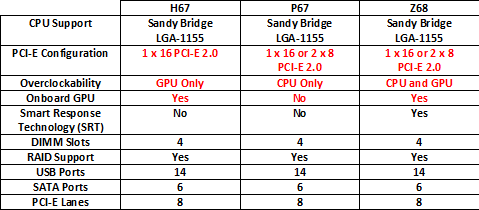Specifications, Overview, and Features
Here is a quick stat-sheet of the different chipsets and what they offer. As you can see, the Z68 chipset is identical to the P67 except only in two areas:
Core elements and enhancements the Z68 chipset brings:
To start off the review, I would first like to thank Gigabyte for providing the Z68X-UD3H-B3 for testing. The extensively advertised features, and the board itself, certainly performed beyond what was expected.
Talking about features, here are a few (of the many listed on Gigabytes Z68X-UD3H-B3 website) that caught my attention as they are important:
Gigabyte DualBIOS is a patented technology that automatically recovers BIOS data when the main BIOS has crashed or failed. Featuring 2 physical BIOS ROMs integrated onboard, Gigabyte DualBIOS allows quick and seamless recovery from BIOS damage or failure due to viruses or improper BIOS updating. In addition, Gigabyte DualBIOS now supports 3TB+ (terabyte) hard drive booting without the need for partitioning, and enables more data storage on a single hard drive.
Intel Smart Response Technology
Gigabyte Z68 series motherboards are equipped with the much anticipated Intel Smart Response Technology, allowing users to experience system performance similar to SSD only systems. IntelSmart Response technology works by using intelligent block-based caching of frequently used applications to improve system performance and responsiveness. In fact, Gigabyte Z68 motherboards with IntelSmart Response Technology are able to outperform hybrid drive systems by more than 2X (PCMark Vantage) and HDD-only systems by as much as 4X (PCMark Vantage).
 Switchable Graphics with LucidLogix Virtu GPU Virtualization
Switchable Graphics with LucidLogix Virtu GPU Virtualization
Gigabyte Z68 motherboards are enabled with LucidLogix Virtu GPU Virtualization technology which allows users to dynamically switch between their built-in graphics and their high-end, 3D discrete graphics cards. This is ideal for gamers who require high-resolution gaming and still want to enjoy the built-in media features of 2nd generation Intel Core processors. In so doing, switchable graphics helps to dramatically reduce PC graphics power consumption.
Multi-display support with CrossFireX and SLI
Flexible graphics capabilities supported for either CrossFireX or SLI action, delivering the ultimate in graphics performance for gaming enthusiasts who demand the highest frame rates without compromising on resolution.
The Intel Smart Response Technology is definitely the most intriguing feature of the Z68X-UD3H-B3 (and hence the Z68 platform), as it claims to drastically decrease load times by utilizing the SSD cache on a secondary hard drive.
However, the multi-display and Quick Sync GPU transcoding provided by LucidLogix are compelling features in their own right. Support for both hybrid NVIDIA and AMD cards is a great add-on, and the ability to effortlessly switch between a dedicated GPU/GPUs and the graphics processor provided by a Sandy Bridge CPU not only allows for more efficiency in performance, but also allows the user to experience features unique to both mediums.
NEXT: Closer Look, Specifications, and Benchmark Testing Platform
Page 1: Introduction
Page 2: Specifications, Overview, and Features
Page 3: Closer Look, Specifications, and Benchmark Testing Platform
Page 4: CPU Benchmarks
Page 5: Computation and Productivity Benchmarks
Page 6: Storage and Peripheral Benchmarks
Page 7: Memory Benchmarks
Page 8: Gaming Benchmarks
Page 9: Overall System Benchmarks
Page 10: Z68 Chipset-Specific Benchmarks
Page 11: Temperature, Power, and Efficiency
Page 12: BIOS and Overclocking
Page 13: Final Words and Conclusion
 The SSD Review The Worlds Dedicated SSD Education and Review Resource |
The SSD Review The Worlds Dedicated SSD Education and Review Resource | 
